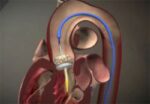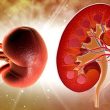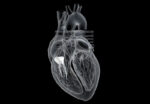Original title: Impact of a New Conduction Defect Alter Transcatheter Aortic Valve Implantation on Left Ventricular Function Reference: Rainer Hoffmann, et al. J Am Coll Cardiol Intv 2012;5:1257– 63. TAVI development in high risk patients can produce new conduction defects and require a definitive pacemaker in almost a third of treated patients. The aim of this study was...
Aortic insufficiency has a poor prognosis in TAVI.
Original title: Impact of Post-Procedural Aortic Regurgitation on Mortality Alter Trancatheter Aortic Valve Implantation Reference: Kentaro Hayashida, et al. J Am Coll Interv 2012;5:1247-56 Transcatheter aortic valve implantation (TAVI) sprung up as a valid strategy to treat patients with severe high risk AS (aortic stenosis). However, residual aortic regurgitation (post AR) and post-dilation remain unsolved. Between October 2006...
TAVI, more risky in patients with peripheral vascular disease
Reference: Sinning et al. AHJ Am Heart J 2012;164:102-110 Percutaneous aortic valve replacement (TAVI) is a novel technique for the treatment of severe aortic stenosis (SAS) that has been built with great enthusiasm in clinical practice, particularly in patients with excessive surgical risk. In these patients, a high obstructive peripheral vascular disease stands, a fact...
Selecting Renal Denervation Responsive Patients: Meta-Analysis of Observational Data
Hypertension treatment has evolved considerably over time. However, managing adverse events driven by medication is still challenging, as is low patient adherence, be it because of polimedication or associated costs. Approximately 10% of patients do not reach optimal blood pressure targets, despite adherence optimal medical treatment (OMT); this condition is known as resistant hypertension. Renal...
National and Internacional Live Cases at the Next SOLACI-CACI 2024
Discover all the live national and international cases at the upcoming SOLACI-CACI 2024 Congress.
Myocardial Damage in MAC
Mitral annulus calcification (MAC) affects between 8% and 23% of the population. It is more common in women and patients with renal insufficiency. This phenomenon is characterized by an increase in valvular annulus fibrosis, which can extend and affect the leaflets. The presence of MAC is associated with valve regurgitation or stenosis, increasing mortality and...
Revascularization Timing in Acute Coronary Syndrome
Multivessel disease is often present in ST elevation acute myocardial infarction (STEMI) patients. The AHA/ACC 2021 revascularization guidelines recommend staged complete revascularization as class I, single-setting complete revascularization as class 2b, and recommend against culprit only revascularization. At present, we have more randomized studies (BIOVASC, FIRE and MULTISTAR) comparing staged vs single-setting complete revascularization, but...
Edge-to-Edge Repair for Right Ventricular Function Deterioration
Tricuspid regurgitation (TR) has been associated with worse survival and hospitalization for cardiac failure (CF). The current guidelines recommend surgery as treatment, despite its 8 – 15% 30-day mortality rate. And there is no mention of a transcatheter intervention, especially for patients with severe TR and right ventricular deterioration. Several percutaneous intervention devices have recently...
Evolution of Cardiac Damage in MitraClip
Degenerative mitral valve regurgitation affects the mitral apparatus and is related to severe insufficiency. At present, surgery is the treatment of choice for patients at low risk. Oftentimes, this disease affects the elderly and/or those at high surgical risk, edge-to-edge repair being an excellent treatment alternative. We all know that the different stages of ventricular...
Cardioband in Tricuspid Valve Regurgitation
Untreated tricuspid regurgitation (TR) has been associated to high morbimortality. Surgical treatment of isolated severe TR is complex and carries a high mortality rate. A transcatheter treatment of this valve is currently being developed, and different concepts are being applied to the new devices. Even though most TR is secondary, atrial functional tricuspid regurgitation (A-FTR)...








